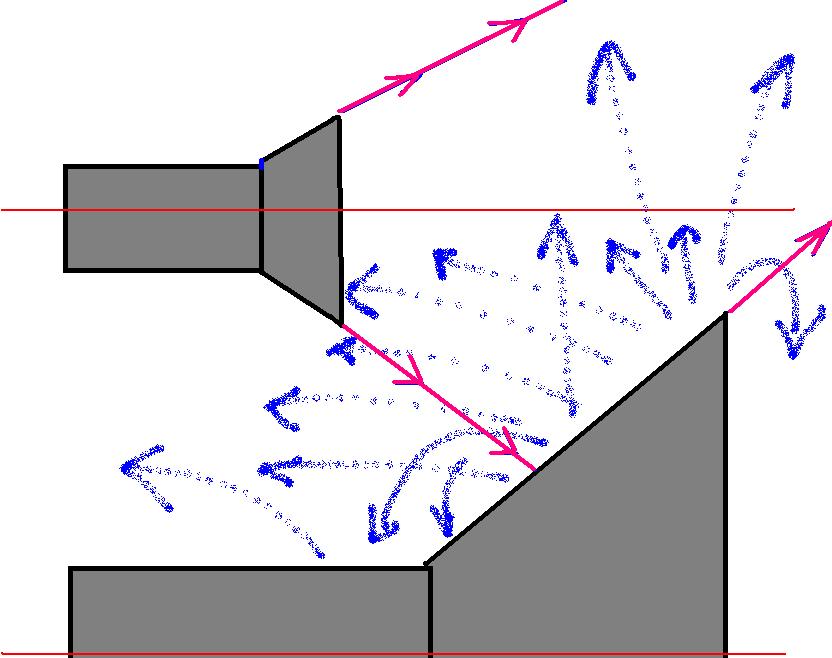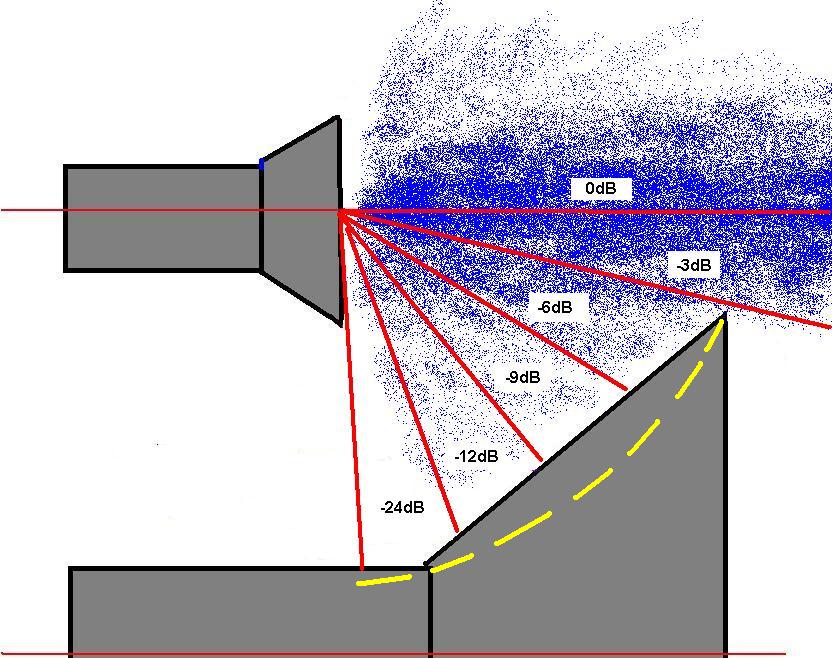Rerurn to Romy the Cat's Site
In the Forum: Horn-Loaded Speakers
In the Thread: Stop having a fear of horn vignetteing
Post Subject: Stop having a fear of horn vignetteingPosted by Romy the Cat on: 12/14/2007
There is a popular myth that all horn people in one way or another subscribe to. They believe that reflections from higher frequency horns off the bodies of lower frequency horns is unavoidable destructive price to pay for horns time aliment.
This myth is juts myth and also it has well-rational logical bearing but it also has no practical, applied meaning and should be virtually discarded
So, what the story? Look at the picture below:

Sound rushing out of mouth of the higher frequency horn meets the impediment in shape of lower frequency horns, got reflected, mess up and the… game is over: cut your horn to firewood and never do this mistake again. Everything indeed looks very logical except that the people who make those logical clams have nether applied experience nether with horns generally nor with sense of own hearing. I have been arguing this myth with people for years...
Let look at the problems from my perspective – the person who actually deal with horns. What I was able to observe is that the effects vary from “practically not auditable” to, in most of the cases, “absolutely not auditable”. Let see other logic, look at the picture below:

1) Horns are narrow radiation devises where max output happens at axis of the horn and then drops with increase of off-axis angle. Of cause any lower frequency horns will not cover the line of sight of from higher frequency horn. In fact I always suggest to keep clearness at least enough to be able to see the entire mouth of the from higher frequency horn. So, the lower frequency horn just vignettes higher frequency output and this vignetteing happens at the angle where higher frequency horn has considerably lower output (the numbers of DBs in the picture are juts for illustrative purpose, the real number would depends from profile of the horn, horn rate, surface type and a few other things)
2) The reflection is there of course, so what would it affect and how the reflection could be evaluated. Dose reflection exists only in theoretical domain? Let see. The higher frequency is HF and therefore it might be very easily managed by absorptions. I tried very many absorbers, including the extremely sophisticated and elaborate… and I fractals heard no different in Sound. No tonal influence, no imaging influence (this should be affected first), no channels clearly influence, no channels harmonics change. Not to mention that the back side of the horns might be done curved (yellow puncture line) to drive the reflection even lower. ( I do not use any flat surfaces if I can, they are are bad for anything)
3) Let look at the subject more anal-retentive – what the reflection should affect. They should mess up the throat reactance of the higher frequency horn. OK, measure impulse response in higher frequency horn that shoots in open air and then with lower frequency horns vignetteing the higher frequency horn at distal of 2 feet. Do you see any different? Not at all. Make more accurate test. Take you higher frequency horn that shoots in open air (not vignetteing) and attach it you your power amp. Right next to this higher frequency horn place another higher frequency horn with the same driver and attach the driver’s output to a scope or UV/DB meter. Run you horn from your amp and use the second horn as a microphone to pick up the sound that reflected from your room. You might run dial-channel scoop and at different sensitively of scoop’s channels you should be able roughly to equalize the outs of your signals and what your horn-microphone will pick up. Use different frequencies or musicals signal. Let pretend that you have 50dB difference between sound pumping into the room and sound that you pick from the room (it will wary from many factors). Now begin to slide your lower frequency horn in its position makes it to vignette the higher frequency horn. At the distance over 2-3 feet you would hardly see any difference what the horn-microphone will pick up and if you do see it will be leas then 1dB (and it is at 50dB scale). What you will be doing it make sure that your higher frequency horns are parallel and equally far from the surface of the lower frequency horn. At this point you might play with absorbers if you wish to driving the delta from 1dB to 0.8dB 0 it all not auditable anyhow.
So the point that I am trying to make is that evil of horn vignetteing is very much blown up. It might not look sexy for some when a part of lower frequency horn is hanging in a way of higher frequency horn but it has negligible sonic impact. It has much-much-much sonic impact then time-misaligned drivers of neighboring lower frequency horns and higher frequency horns.
Rgs, Romy the caTRerurn to Romy the Cat's Site